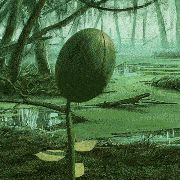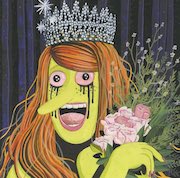|
|
they're just far away tho
|
|
|
|

|
| # ? May 8, 2024 21:36 |
|
|
tiny flowers are v important for situations where an ant wants to impress his ant girlfriend, for example
|
|
|
|
Fire types are good against grass types. We've known this since we were babies. But what if there was a flower capable of starting fires? Indeed many eucalyptus trees do just that but let's look at something a bit smaller.  Dictamnus, or gas plant is a gorgeous specimen in the citrus family, Rutaceae. Like other members in that family, the plants produce various volatized aromatic oils with the blooms themselves smelling of lemon. Now, when it's super toasty outside in the peak of summertime, Dictamnus will increase the production of isoprene, which aides against heat stress but has a fun side effect if it get's sufficiently hot.  The volatile oils catch flame in an upwards burst, harmlessly burning away without causing any danger whatsoever to the plant.  Here it is again on some older, spent flower stalks. No one's sure if it's an adaptation against errant sparks or if it's perhaps a method of eliminating nearby competition by causing fires. It could also just be a fun byproduct of its natural oil production capabilities. |
|
|
|
|
Plant MONSTER. posted:Fire types are good against grass types. We've known this since we were babies. That is the most badass plant. I am going to go look for one when I eventually can travel to where they live. |
|
|
|
You might not want to go starting brush fires right now lol |
|
|
|
What's good about flowers is just how clearly their colors pierce through all the green that surrounds them, ensuring they're seen by the correct interested parties. Big, opaque and bold petals. Opaque being the key word because flow- W-w-what? The opacity! It's non-existent! What gives?! Diphylleia, I guess, play by their own rules...  The petals are actually normally white on these guys but once they get moist, the flowers turn clear with only a small lattice of slightly less transparent "scaffolding" persisting. Once dry, they revert back to their white coloration.  We're not sure why exactly the flowers exhibit this property. "We don't know." is a common answer to "why is this plant doing this?" If you live in the Appalachian Mountain area, you might be able to find these guys growing wild. If not, you'll need to take a trek to China or Japan.  Their leaves are so distinctive! |
|
|
|
|
Plant MONSTER. posted:
no ring...hell, no hands
|
|
|
|
i'm not a flower expert but maybe there's an advantage to only attracting insects when your pollen is dry and powdery?
|
|
|
|
nut posted:no ring...hell, no hands what's that leaf doing to its petiole! |
|
|
|
Sherbert Hoover posted:i'm not a flower expert but maybe there's an advantage to only attracting insects when your pollen is dry and powdery? That's actually the cleverest suggestion I've seen for this phenomenon ever. |
|
|
|
Plant MONSTER. posted:That's actually the cleverest suggestion I've seen for this phenomenon ever. i look forward to seeing byob cited in your paper |
|
|
|
|
Bo-Pepper posted:what's that leaf doing to its petiole!
|
|
|
|
We saw weird parasitic flowers earlier and we're about to take a look at another example, this one being a little bit showier, imo. Groundcones are plants in the genus Boschniakia... but depending on who you ask, the different species that make up Boschniakia might be broken up into their own genera, like Kopsiopsis. Let's not worry too much about that. Groundcones get their name because they resemble pinecones that burst directly out from the ground. The only part of the plant we see are the large inflorescences. They parasitize many kinds of plants, not being nearly as picky as Sapria, earlier, which needs a specific species to live off of.  Boschkiania rossica's inflorescence.  Kopsiopsis hookeri's blooms erupt in various shades that look like they were handpicked to look good together  They can even be yellow sometimes. |
|
|
|
|

|
|
|
|
Wish you could enjoy roses for their prickles* and not their smelly obnoxious blooms?  While normally I like to focus on flowers, I've decided that flowering plants themselves are fair game. Rosa sericea subsp Omeiensis f. Pteracantha or the far more succinct winged thorn rose.  Look at how viciously equipped that stem is! It's so strangely beautiful too.  The large red flat prickles are actually quite pliable... for now.  When the canes become old and die however they turn into a very sharp weapon.  the flowers of this rose are also highly unusual from other members in its genus in a few ways. It has four petals instead of the usual five seen in other species. Also, the way the flowers emerge from the stem a short distance. |
|
|
|
|
Plant MONSTER. posted:We saw weird parasitic flowers earlier and we're about to take a look at another example, this one being a little bit showier, imo. Groundcones are plants in the genus Boschniakia... but depending on who you ask, the different species that make up Boschniakia might be broken up into their own genera, like Kopsiopsis. Let's not worry too much about that. I didnít realize they were growing off micorrhizae, thatís like double mycorrhizal action! |
|
|
|
While not necessarily weird, I like to feature flowers in extreme sizes both tiny or huge. Cardiocrinum giganteum is a huge member of the lily family. Although it's not in the same genus as the lilies we find at flower shops, they are certainly no less fragrant.  Native to the Himalayas, China and Myanmar these puppies can reach a staggering 3.5 meters tall or approx 11.5 feet tall. If you've ever been in an enclosed room with lilies, you can know just how strong they can smell. It's pleasant enough at first but after a bit, there's this... turpentiny/acetony smell that's really headache inducing. These giant lilies are even more efficient at diffusing their fragrance over a massive area.  look at how tiny it makes this lady look |
|
|
|
The corpse flower is about to bloom at KU https://lawrencekstimes.com/2021/09/10/corpse-flower-to-bloom-ku/ 
|
|
|
|
Nice! I'd love to see one in person. I'll be mentioning the Amorphophallus titanum when I go over the extreme size disparity of flowers in the Araceae family! Oddly enough, I think my favorite part of the Amorphophallus genus is the fact the one leaf they produce ends up looking like an entire tree. Plant MONSTER. fucked around with this message at 15:14 on Sep 11, 2021 |
|
|
|
|
KaBob posted:The corpse flower is about to bloom at KU I saw one of these at Kew Gardens once! They say it smells like corpses, but being unfamiliar with the smell of corpses, I thought it smelled more like garbage. |
|
|
|
Kaiser Schnitzel mentioned a plant called dodder earlier, so let's take a look at that. Dodders are a group of about 200 species in the genus Cuscuta in the morning glory family, Convolvulaceae. Dodder basically resembles spaghetti that someone sprinkled over trees and herbs like tinsel. They have low levels of chlorophyll usually and thus get most of their nutrients by stealing from other plants.  They can come in all sorts of colors, ranging from chartreuse to ruddy red. The greener ones can actually photosynthesize a little bit but still requires supplementation via a host. But this thread is mostly about flowers. So surely, they must flower! Most dodders will form little clusters of flowers ranging in colors from white and cream to pink.  One particular species caught my eye, however and that's Cuscuta glomerata or "the rope dodder"  Like a beautiful, twisting garland of perfect tiny white flowers! |
|
|
|
|
hey plantmonster, I saw these today and I was able to recognize them as maybe groundcones due directly to this thread: so that's pretty neat! keep the thread going, it's real interesting.
|
|
|
|
Pollen is incorrectly referred to as plant spooge by the layman but this isn't actually accurate. If anything, it's best to think of as each pollen grain as its own ballsack that produces sperm. Most pollen grains from flowering plants contain two types of cells, one is called a vegetative cell - it grows into a tube that penetrates into the ovary once the pollen grain lands on a compatible stigma and the other cell, called the generative cell is what divides into two sperm cells. Pollen is not a cost-effective thing for a plant to produce, all things considered, so it's a bit wasteful to just hand it out all willy-nilly, eh? Many plants have adapted some fun strategies to ensure pollen isn't wasted. We saw one such adaptation earlier with the moving Stylidium plant. But those who stuck around for BYOBmovie's documentary month may remember another strategy that was mentioned in one of the docs we watched. Orphium frutescens is a beautiful subshrub native to South Africa.  The bright yellow anthers look absolutely packed with delicious, nutritious, proteinaceous pollen! But brush up against them as much as you want - you won't be able to dislodge the pollen. The anthers are actually very tightly coiled and need the presence of a female carpenter bee to release its pollen. It's actually the frequency of her wingbeats that cause the anthers to vibrate in just the right way to send the pollen flying out! When the bee lands on a flower, she changes the frequency close to that of middle C.  here's a little video of it here: https://www.youtube.com/watch?v=N72KFpvIiss |
|
|
|
|
that's amazing! is the pollen itself nutritious enough to make it worth the bee's while? it must be.
|
|
|
|
You know, even with the internet and all its glory, what's common and well known in one part of the world still remains a complete novelty to someone somewhere else. I've only recently became aware of a most beautiful flowering plant: Melampyrum nemorosum. It's such an explosion of color, so it's no doubt that those who come across it in its native range come to love them so. They're found all across most of Scandinavia and much of Russia.   It's so gorgeous, I couldn't believe it. The newer leaves on the apical point of the plants emerge in the boldest blue-violet color imaginable. As they age, they fade to a green, often with a gradient to it. These guys are considered a hemi-parasite, they can bogart water and nutes from neighboring plants but this isn't absolutely vital to their survival. I guess we can consider it tax for looking so good? |
|
|
|
No fancy pants Fotos but my morning glories have started blooming! One plant is a blue-purple gradient petal, and the other has two colors so far that I can tell. Full on blue-white, and this warmer, redder mix that I'm waiting to categorize. Oh yeah, and the plants reached across the gap and merged together entwining their vines so they're dating now.   
Viginti Septem fucked around with this message at 16:41 on Sep 19, 2021 |
|
|
|
Here's a picture of them holding hands 
|
|
|
|
Hibiscus is in bloom so I grabbed a couple of pics: 
https://i.imgur.com/QKTkerO.mp4 |
|
|
|
Hi, biscus! |
|
|
|
|
man I just want a thousand page thread of all this rn, itís super soothing. i just want to read about cool plant things and feel calm.
|
|
|
|
|
teen witch posted:man I just want a thousand page thread of all this rn, itís super soothing. i just want to read about cool plant things and feel calm. |
|
|
|
It's rose time again! What is the biggest rose? Well the largest in flower diameter would be those of Rosa odorata var. gigatea  This is a very tender rose that is rarely grown but it can scramble up to 50-60 meters. It has however, been widely used in the breeding of other rose varieties, so there's that. The largest rose in terms of sheer mass though?  Whoa. This is a humungous Rosa banksiae or Lady Banks' rose that's been grown in Arizona. She's known as the shady lady and she is over one hundred years old. A person can comfortably sit inside the gnarled trunk because it's thornless as well!  Here she is in bloom! I bet the whole area smells so sweet.  Normally this type of rose bush is kept in checked and don't grow nearly as large. They do offer a beautiful display once per year! |
|
|
|
|
Lithops  
|
|
|
|
The aroid family, Araceae contains some of the world's most beloved houseplants, including Spathiphyllums, Anthuriums, Dieffenbachias, Philodendrons, Monsteras, Epipremnums, Alocasias/Colocasias, Syngoniums, Zamioculcas and many many more. Aroid flowers are pretty noteworthy because they tend to develop a flower called a spadix, which is a rod shaped structure packed with flowers. The spadix is usually divided with the top half having flowers of one sex and the bottom, the other.  This Anthurium shows off the spadix quite well. The family is noteworthy for a different reason as well. Surely you're heard of the giant corpse lily, Amorphophallus titanum that KaBob shared with us earlier.  This thing is the largest unbranched inflorescence in the world. What I mean by unbranched is, picture the flowers on a lilac tree or a hydrangea, the entire cluster of flowers is known as an inflorescence. It's made of up of many individual flowers borne on small stems known as peduncles (or pedicels if the peduncles themselves branch off). The Amorphophallus inflorescence would thus be that huge wiener shaped structure. So the largest individual solitary flower would the Rafflesia. The largest inflorescence are thus broken into two groups: unbranched, going to the Amorphophallus and branched, which goes to a type of palm, Corypha umbraculifera. But aroids also hold the distinction for another size record: the smallest flowers! Wolffia is a very very tiny aroid that grows on water. You've probably seen it and its relatives many times before.  These rapidly growing plants replicate themselves so quickly because they reproduce vegetatively fairly rapidly.  But they can still produce flowers and breed the old fashioned way! The flowers emerge from a tiny depression in the middle of the plants.  So... So tiny... |
|
|
|
Wolffia Macroscopia proving it's not the size of the stamen |
|
|
|
I, too, emerged from a tiny depression, in a plant. |
|
|
|
Plant MONSTER. posted:You know, even with the internet and all its glory, what's common and well known in one part of the world still remains a complete novelty to someone somewhere else. I've only recently became aware of a most beautiful flowering plant: Melampyrum nemorosum. these friends are little amazing fractals i love them with every ounce of my very large heart (i am a blue whale posting telepathically)
|
|
|
| f l o wers | |
|
|
|
|
This thread delivers on cool and weird.
|
|
|
|

|
| # ? May 8, 2024 21:36 |
|
|
plants are dope as hell and one of my favourite activities in the spring and summer is to go out hiking with my kids and take pictures of every plant out there with my plant id app and tell them what it is (and they always ask me if they can eat it  ) )
https://i.imgur.com/W7qTiB3.mp4 |
|
|









































